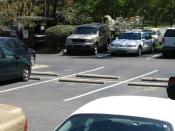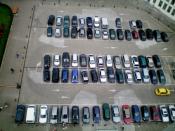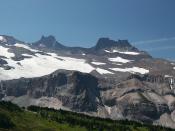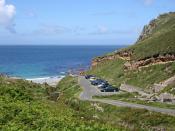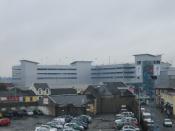Sociology 101 "How is an ongoing setting of social interaction continually being organised by the participants of that setting?" For my study in this subject, I chose a setting I frequently engage in and observe. This setting is the shopping centrecar park. In the study of the patterns of behaviour that make up the organising of this setting, I observed how people engaged in the work of using and maintaining the car park, discovering that there is a complex set of rules that each driver is morally constrained to follow. I found there was quite a lot of work involved in the maintaining of the setting, which I will briefly describe in the body of this paper. I also discovered quite an interesting phenomenon of which I had previously given little thought, that is, that driving rules differ depending on how crowded the car park is and on the availability of car spaces.
I studied several car parks, which I use on a regular basis. The one I frequent the most is described in this essay. The phenomena I observed, however, occurred in the variety of car parks I visit.
This car park is attached to a major shopping centre, which is usually extremely busy. It is a multi-levelled complex with ramps that lead up to higher levels and ramps that lead down to the exit. On each level there is a road with car spaces to each side of it. Yellow arrows painted on the road indicated the direction, which should be followed.
I observed that drivers entered the car park from the street and observed the direction of the traffic inside the centre, indicated by the yellow arrows. Drivers began observing how crowded the car park was by assessing how many spaces were available. As people drove around the parking centre, they typically drove slowly and turned their heads observing if any spaces were available. They maintained a certain distance behind the driver in front (if there was one). The road was one-way, and drivers drove to the left hand side and used the right hand lane to overtake cars that were stationary on the left.
If spaces were not available on one level, drivers proceeded to drive in the direction indicated by the yellow arrows to the next level up. If no spaces were available on this level, they continued upward again.
If the parking area was not crowded, and many spaces available, "ÃÂnormal' road rules applied. That is, the drivers who were exiting from car spaces gave way to drivers driving on the road, and the driver looking for spaces had a choice of where they would prefer to park. They indicated in the direction they would be turning and drove into the space. The most valuable spaces appeared to be those near the entry to the shopping centre on each level. These spaces went first.
If the car park centre was crowded and few parking spaces available, different rules and behaviour applied. Cars followed each other, maintaining a certain distance, the cars proceeded at a slow speed. Drivers frequently turned their heads to look to see if spaces were available along that row, and sometimes attempted to look into the next row to see if any available spaces where there. The drivers observed other drivers in moving cars, parked cars, people loading cars and walking to cars in an attempt to determine whether a space was available or would soon become available. Sometimes determining whether a space would become available involved communicating with the people approaching cars, people sitting in cars or standing around cars. I observed some drivers asking pedestrians if they were leaving or had they just arrived. If a space became available or was soon to become available, then it was then necessary to analyse whose space it should be. All of this observing and analysing needed to be done while the car was still moving so as not to impede traffic.
The determining of ownership depended on what position the searching car was in, whether they were before the car space or after, if they were pulled up waiting for the car space or indicating in another way that the space belongs to them. If a car had just passed a space, which had become available, they missed out on the spot. The next car approaching the spot was entitled to it, depending on whether they indicated, pulled over and claimed ownership.
.
Where the normal road rules (and car park rules) differ was that the cars on the road inside the car park gave way to the driver exiting the car space. Normally the cars exiting would need to give way to drivers already on the road, but it appeared that in this circumstance they had something the other driver wanted and needed (the space they were exiting from) so they exited first.
There is also a role for the passenger of the car. I found I was expected to look for spots, often looking one way while the driver looked the other way. I observed passengers of other cars appearing also to look for spots. If a spot was sighted, the passenger should tell the driver a spot is available, after analysing first whether the spot belonged to another driver or whether the driver of their vehicle would be able to reach the space before another driver.
I visited this car park as a passenger in the cars of several different drivers. Although I did not indicate to the drivers that I was studying this phenomenon, doing this allowed me to see what these drivers viewed as breaking the rules of the car park procedure. The "ÃÂrule-breaking' behaviour was viewed similarly by each of these drivers, that is that these rule breakers were inconsiderate and not doing "ÃÂthe right thing'. They had violated the cooperative effort (how people have worked together to establish the procedure).
Some of these infringements included drivers who parked crookedly (went outside the yellow lines designating the perimeter of the car space) which made it difficult to park next to them, those who drove against the direction indicated by the yellow arrows, drivers who did not give way or allow enough space for drivers entering or leaving a car space (when the car park was crowded). Each of these drivers also seemed concerned that once they found a space that a car was exiting from, that other drivers would know the space was to be theirs. They each indicated to show other drivers that they were planning to enter the spot when it was vacated and also to claim ownership.
I discovered during this study that quite a lot of work went into producing, managing and supervising this setting. I studied an everyday occurrence in our society and discovered it took more than common sense to participate and maintain this action.
Some of the work I observed that people do in this setting was observing, communicating, analysing and working in cooperation with others. Drivers relied on drivers of other cars to follow these rules and work together There was a moral judgement made about drivers who cooperated in the work of this setting and those that did not. The patterns of behaviour followed by the users of this car park went into managing and producing this setting. It also made up the social order of the society using this setting and constrained them morally.
